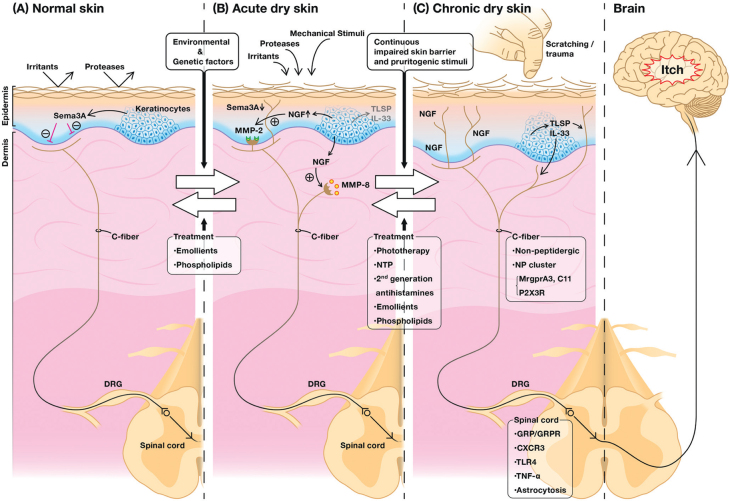Fig. 2.
Mechanisms and management of dry skin-induced itch. The perception of itch starts when endogenous and exogenous itch mediators activate their respective receptors/channels expressed in peripheral sensory afferents. Electric signals generated in the peripheral nerve endings are transmitted to the somatosensory cortex in the brain through the spinal cord, resulting in the recognition of itch. (A) In healthy skin, Sema3A, a nerve repulsion factor (NRF) produced mainly by keratinocytes (KCs), is dominant. It maintains the cutaneous nerve fibres under the dermo-epidermal junction. (B) During environmental stimuli in acute dry skin conditions, nerve growth factor (NGF), an epidermal nerve elongation factor (NEF) produced by KCs, is prominent and induces the elongation of cutaneous nerve fibres into the epidermis. This elongation may also be affected by thymic stromal lymphopoietin (TSLP) and interleukin (IL)-33 released from KCs. NGF also promotes matrix metalloproteinase (MMP)-2 and MMP-8 production in sensory nerve fibres, which leads to the penetration of nerve fibres into the basement membrane and their growth. Emollients and phospholipids are effective at alleviating the symptoms in this phase. (C) In chronic dry skin accompanying the itch-scratch cycle, such as in systemic or inflammatory skin diseases, more sensory nerve fibres penetrate the epidermis. In addition to substances released from KCs, the non-peptidergic C-fibres (NP cluster) are also involved in itch signalling, along with astrocytosis in the spinal cord. More treatments have been confirmed to be beneficial in this condition.

